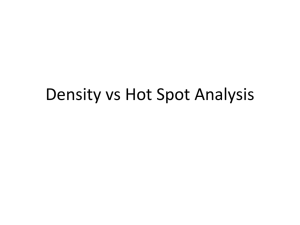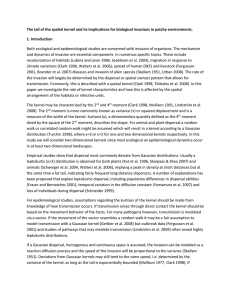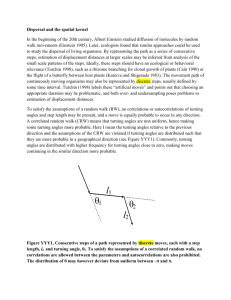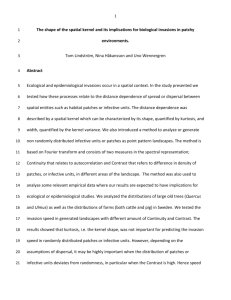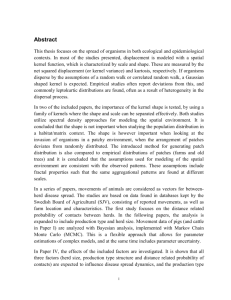Spatial kernel characteristics and the speed of biological and
advertisement
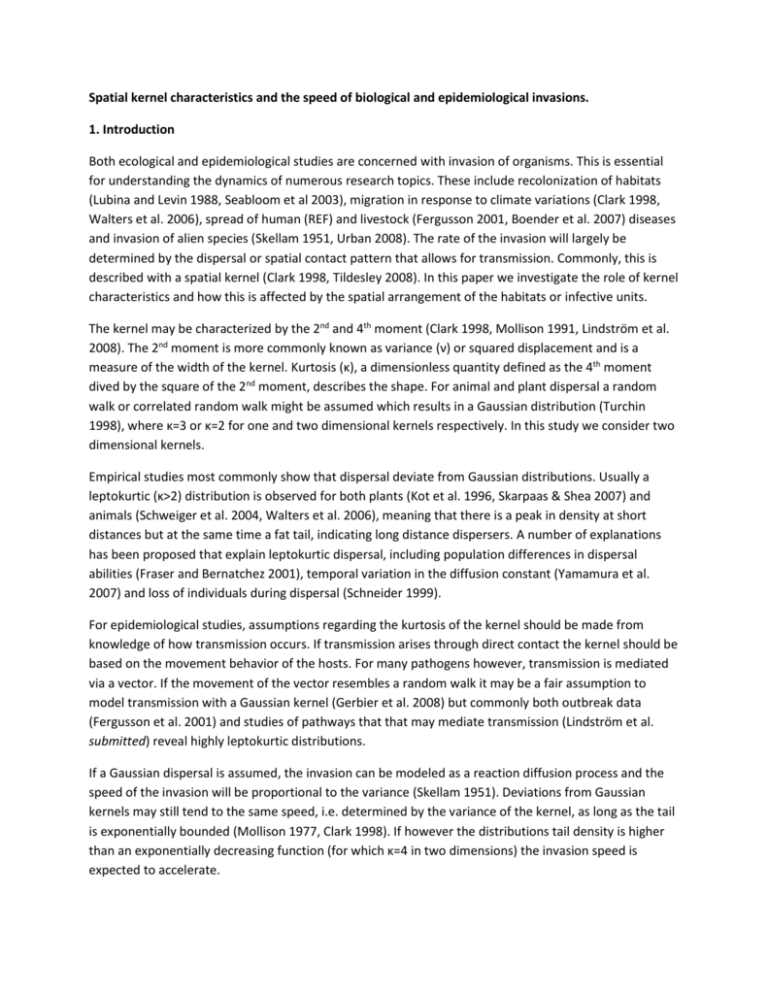
Spatial kernel characteristics and the speed of biological and epidemiological invasions. 1. Introduction Both ecological and epidemiological studies are concerned with invasion of organisms. This is essential for understanding the dynamics of numerous research topics. These include recolonization of habitats (Lubina and Levin 1988, Seabloom et al 2003), migration in response to climate variations (Clark 1998, Walters et al. 2006), spread of human (REF) and livestock (Fergusson 2001, Boender et al. 2007) diseases and invasion of alien species (Skellam 1951, Urban 2008). The rate of the invasion will largely be determined by the dispersal or spatial contact pattern that allows for transmission. Commonly, this is described with a spatial kernel (Clark 1998, Tildesley 2008). In this paper we investigate the role of kernel characteristics and how this is affected by the spatial arrangement of the habitats or infective units. The kernel may be characterized by the 2nd and 4th moment (Clark 1998, Mollison 1991, Lindström et al. 2008). The 2nd moment is more commonly known as variance (ν) or squared displacement and is a measure of the width of the kernel. Kurtosis (κ), a dimensionless quantity defined as the 4th moment dived by the square of the 2nd moment, describes the shape. For animal and plant dispersal a random walk or correlated random walk might be assumed which results in a Gaussian distribution (Turchin 1998), where κ=3 or κ=2 for one and two dimensional kernels respectively. In this study we consider two dimensional kernels. Empirical studies most commonly show that dispersal deviate from Gaussian distributions. Usually a leptokurtic (κ>2) distribution is observed for both plants (Kot et al. 1996, Skarpaas & Shea 2007) and animals (Schweiger et al. 2004, Walters et al. 2006), meaning that there is a peak in density at short distances but at the same time a fat tail, indicating long distance dispersers. A number of explanations has been proposed that explain leptokurtic dispersal, including population differences in dispersal abilities (Fraser and Bernatchez 2001), temporal variation in the diffusion constant (Yamamura et al. 2007) and loss of individuals during dispersal (Schneider 1999). For epidemiological studies, assumptions regarding the kurtosis of the kernel should be made from knowledge of how transmission occurs. If transmission arises through direct contact the kernel should be based on the movement behavior of the hosts. For many pathogens however, transmission is mediated via a vector. If the movement of the vector resembles a random walk it may be a fair assumption to model transmission with a Gaussian kernel (Gerbier et al. 2008) but commonly both outbreak data (Fergusson et al. 2001) and studies of pathways that that may mediate transmission (Lindström et al. submitted) reveal highly leptokurtic distributions. If a Gaussian dispersal is assumed, the invasion can be modeled as a reaction diffusion process and the speed of the invasion will be proportional to the variance (Skellam 1951). Deviations from Gaussian kernels may still tend to the same speed, i.e. determined by the variance of the kernel, as long as the tail is exponentially bounded (Mollison 1977, Clark 1998). If however the distributions tail density is higher than an exponentially decreasing function (for which κ=4 in two dimensions) the invasion speed is expected to accelerate. Traditionally studies of invasion speed assume homogenous and continuous space but resent work has turned their attention to heterogeneous landscapes (Smith et al. 2002, Urban et al. 2008). In this paper we focus on invasion of organisms in environments where the habitats or infective units are best represented as discrete entities with a fixed spatial location. Examples of this are studies of livestock epidemics (Keeling 2001, Boender et al. 2007) and ecological invasions where habitats are considered as isolated patches surrounded by a hostile matrix (as is done in metapopulation studies). Our aim in this paper is to explore the role of κ and ν of the spatial kernel for invasion speed and thereby investigate what needs to be estimated to make predictions on this. We expect that this may also depend on the spatial pattern of focal entities. We therefore incorporate spatial aggregation patterns and describe this with spectral density. To exemplify what spatial patterns may be found in areas where our results have implications, we also analyze relevant spatial data with a method given by Mugglestone and Renshaw (2001). We examine Swedish data of pig and cattle farms as well as distribution of two tree species, oak (Quercus) and elm (Ulmus). The two first have implications for spread of livestock and poultry diseases respectively while the latter are relevant for possible recolonization by saproxylic insects. Many of these are endangered in Sweden and limited dispersal has been proposed to be a mayor explanation (Ranius 2006, Hedin et al. 2008). Spread of elm disease (Ophiostoma ulmi) is also an area where our results are relevant. 2. Material and Method 2.1 Kernel variance and kurtosis In this paper we model the spatial kernel with a generalized normal distribution (Nadarajah 2005). In Lindström et al. (2008) this is extended to two dimensions for symmetrical kernels. Kernel density is given by PD e a d b S where d is the distance and S is a normalizing constant which in two dimensions is given by S b . 2a1 b Parameters a and b determines ν and κ of the kernel. For two dimensions these are given by 4 b a2 2 b 6 2 b b 2 4 b 2.2 Spectral density and point pattern Spectral density has been used frequently for time series and lattice data (see Mugglestone and Renshaw 1996 for relevant references). The basis of the spectral method follows from the Fourier theorem where it is stated that the density in the time series or lattice can be represented by a combination of sine waves, w with different frequencies and amplitudes. This combination is preferably found using a Fast Fourier Transform (FFT). Analysis can then be performed on the sine waves. If the logarithm of w frequency is plotted against its amplitude, the slope of the curve… Här får nog Uno och Nina skriva… Here we present two measurements required to capture the spatial point pattern. The first is Contrast (δ), which is a normalized measure of density dispersion. Large values of δ means that there is a large difference between sparse and dense areas. We measure δ in the frequency domain as In med ekvationen för contrast. Secondly, Continuity (γ) is a measure of spatial auto correlation over multiple scales. Large values of γ means that nearby areas have similar density. It is measures by the relationship between Fourier frequency and amplitude and in this study we assume a linear relationship. Hence γ is given by the slope of linear regression fitted to the log(frequency) vs. log(amplitude). 2.2.1 Generating neutral point pattern landscapes Keith (2000) defined neutral landscapes for lattices as models where the value at any point in the landscape can be considered random and pointed out that this does not exclude models whit spatial autocorrelation. This definition may also be applied to point pattern landscapes where the distribution of points may deviate from random as long as the exact position of a point cannot be predicted. We used a set of such landscapes to test the effect of kernel characteristic under different patterns of spatial aggregation. We refer to these as Neutral Point Pattern Landscapes (NPPL). To get NPPL with given characteristics we generated lattice landscapes of size m×m. The density defines the probability of a point in the landscapes. We first generated 2-dimensiona1/|𝑓|𝛾𝐿 -noise (denoted LG) using a method similar to that presented by Halley et al. (2004). The values in LG are normally distributed and since this may include negative values it is not suitable for describing probabilities. We therefore transformed LG using spectral mimicry. This method is defined by Cohen et al. (1999) and has been used when applying Fourier series to time series analysis. Cohen et al. presents the method for transformation to a series with normally distributed values with a specific mean and variance. We instead transformed LG to LΓ using a Γ distribution (which contains no values <0) with mean=1/m2 and coefficient of variation δL. Point locations were distributed according to the probabilities given by LΓ. While γ and 𝛿 of the spectral point pattern is determined by γL and δL, they are altered by both the Γtransformation of the grid values and the distribution of points. Hence we measured these quantities in the generated landscape (with method given in above). The relationship between spectral point pattern values of γ and 𝛿 used in the study and the γL and δL required to generate them was found iteratively. 2.3 Monte Carlo simulation 2.3.1 Probability of colonization The probability of colonization from one occupied patch to an unoccupied can be modeled differently, corresponding to different assumptions of dispersal. First, on may assume that the probability is only dependent on the distance between the two patches, in which case the probability of patch i becoming occupied within one time step is given by 𝑃(𝑂𝑡+1 (𝑖) = 1|𝑂𝑡 (𝑗) = 1, 𝑂𝑡 (𝑖) = 0) = 𝑅𝑃(𝐷) where Ot(k) is equal to one if patch k is occupied at time t and equal to zero if it is unoccupied, and R is a measure of growth rate. This modeling approach assumes that the probability of colonization from one occupied patch to an unoccupied is independent of other patches. Alternatively one may assume that the colonization potential of all patches is the same. In that case, equation XXX for colonization from patch j is normalized by summation over all patches 𝑘 ≠ 𝑗: 𝑁−1 𝑏 𝑆 = ∑ 𝑒 −(𝑑𝑘𝑗 ⁄𝑎) 𝑘=1 where N is the number of patches. 2.3.2 Simulations The effect of κ and ν on invasion speed was estimated simulations with discrete time. Starting on a point in the center of the landscape we simulated invasions with 200 replicates of each combination of used parameter values (see Table 1). For each simulation we measured the number of time steps, tlim, required to reach a fixed distance, Dlim, and calculated the invasion speed, S, as Dlim/tlim. We used Dlim=0.25 (given relative to the unit square) to avoid severe altering of the kernels variance and kurtosis due to truncation at the edge of the landscapes. The results were analyzed with an ANOVA (type three) for each combination of landscape parameters, using S as dependent variable and ν and κ a categorical predictors. Since the exact value of γ and xxx varies between replicates, these were used as continuous co-variables. The relative effect of kurtosis was calculated Eκ=MSκ/(MSκ + MSν) where MS is mean sum of squares. 2.4 Examples of real point pattern To demonstrate what characteristics may be found in real point patterns where our results are relevant we analyzed spatial data of old oak trees as well as cattle and poultry farms respectively. Data of the two latter was achieved through the Swedish Board of Agriculture and contain the coordinates of farms at 2008-XX-XX. The oak tree data was provided by the Östergötland County Administrative Board and is the result of a massive inventory of old trees in the region during the years XXXX and XXXX. We used oak trees with diameter>1m and/or signs of “rötning”.
